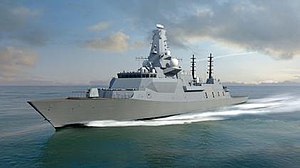Future Surface Combatant

BAE Systems design, 2017
|
|
| Class overview | |
|---|---|
| Name: | Global Combat Ship |
| Builders: | BAE Systems Maritime – Naval Ships |
| Operators: |
|
| Preceded by: | Type 23 frigate |
| Cost: | £8bn programme cost (2016 est.) |
| Built: | Contract award for first three of eight planned ships announced 2 July 2017 |
| In service: | Mid-2020s (planned) |
| Building: | 1 |
| Planned: | 8 |
| General characteristics | |
| Type: | Anti-submarine warfare |
| Displacement: | 6,900 t (6,800 long tons; 7,600 short tons), 8,000+ t full load |
| Length: | 149.9 m (492 ft) |
| Beam: | 20.8 m (68 ft) |
| Propulsion: |
|
| Speed: | In excess of 26 kn (48 km/h; 30 mph) |
| Range: | In excess of 7,000 nautical miles (13,000 km) in Electric-Motor (EM) drive |
| Complement: | 118 (capacity for 208) |
| Sensors and processing systems: |
|
| Electronic warfare & decoys: |
IRVIN-GQ DLF decoys |
| Armament: |
|
| Aircraft carried: |
|
| Aviation facilities: | |
| Notes: | Flexible mission bay |
The Type 26 frigate or City-class frigate is a class of frigate being built for the United Kingdom's Royal Navy. The ship design and manufacture program, known as the Global Combat Ship, was created by the UK Ministry of Defence to partially replace the navy's thirteen Type 23 frigates, and for export. It will be multi-mission warship designed to support anti-submarine warfare, air defence and general purpose operations.
The programme began in 1998, under what was then known as the Future Surface Combatant (FSC). However, by March 2010, this procurement programme had evolved to become the Global Combat Ship, following the announcement of a four-year, £127 million design contract being awarded to BAE Systems Maritime – Naval Ships. The design passed Main Gate 1 in early 2015, with the Demonstration Phase starting 1 April 2015. In August 2015 the first long lead items for Type 26 were ordered, with manufacturing then expected to begin in 2016 and the first Type 26 to be delivered in 2023. In November 2016 it was announced that first steel would be cut for the eight Royal Navy ships in summer 2017. They will be built at BAE Systems' Govan and Scotstoun yards on the River Clyde in Glasgow. The contract award to manufacture the Type 26 was announced by BAE Systems on 2 July 2017, with steel cut for the first of class, HMS Glasgow on 20 July 2017 by the Secretary of State for Defence, Sir Michael Fallon.
The Global Combat Ship started development under the original Future Surface Combatant (FSC) programme intended to replace the Royal Navy's Type 22 and Type 23 frigates. Planning for a replacement escort vessel started in 1998 with the ordering of a research vessel, the RV Triton, to study whether a trimaran design was practical for such a large and complex vessel. However, by the early 2000s it was apparently obvious the Royal Navy favoured more conventional designs. In March 2005, plans were released for a two-class solution, a cheaper "Medium Sized Vessel Derivative" entering service in 2016–19 and a more capable "Versatile Surface Combatant" entering service around 2023.
...
Wikipedia
